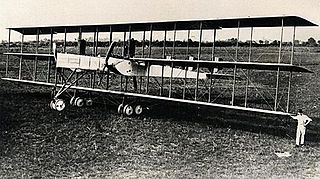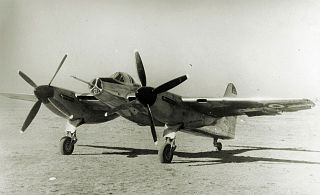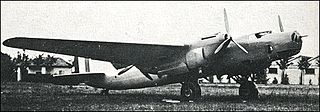
The Caproni Ca.4 was an Italian heavy bomber of the World War I era.

The McDonnell XP-67 "Bat" or "Moonbat" was a prototype for a twin-engine, long-range, single-seat interceptor aircraft for the United States Army Air Forces. Although the design was conceptually advanced, it was beset by numerous problems and never approached its anticipated level of performance. The project was cancelled after the sole completed prototype was destroyed by an engine fire.

The Focke-Wulf Fw 57 was a prototype German fighter-bomber. Prototypes were built in 1936 but never entered production.

The SAAB 21 was a Swedish fighter and attack aircraft designed and manufactured by Swedish aviation company SAAB. It used a relatively unorthodox and visually distinctive combination of a twin boom fuselage and a pusher configuration, giving the aircraft a unique appearance.

The PZL.38 Wilk (wolf) (PZL-38) was a Polish fighter-bomber developed and manufactured by PZL state factory in 1937.

The I.Ae. 30 "Ñancú" was an Argentine twin piston engined fighter designed by the Instituto Aerotécnico in the late 1940s, similar to the de Havilland Hornet, but made of metal rather than wood. Only one prototype was completed; the project was abandoned in favour of a jet aircraft.
The PZL.48 Lampart (leopard) was a Polish heavy fighter-bomber design, that remained only a project, owing to the outbreak of World War II.

The SAI-Ambrosini SS.4 was an Italian fighter prototype developed in the late 1930s, featuring a canard-style wing layout and a pusher propeller. Development of the SS.4 was abandoned after the prototype crashed on its second flight.

The Savoia-Marchetti SM.91 was an Italian long-range fighter-bomber prototype, designed to compete in a contract offered by the Regia Aeronautica to the Italian aircraft companies in 1938.

The Tairov Ta-3 was a twin-engined single-seat heavy fighter designed and produced in the Ukrainian SSR in the Soviet Union from 1939. The Ta-3 was envisioned to serve primarily as an escort fighter. Competing contemporaneous designs in the USSR included the Grushin Gr-1, Mikoyan-Gurevich DIS and Polikarpov TIS.

The Westland Westbury was a British twin-engined fighter prototype of 1926. Designed by Westland Aircraft it never entered service but played a useful role in the testing of the COW 37 mm gun. Only the two prototypes were completed.

The de Schelde Scheldemusch was a single-seat pusher biplane designed in the Netherlands to be easy and safe to fly. It was one of the first light aircraft to use a tricycle undercarriage. Despite a sales campaign in the UK, only six were built, one being briefly tested by the RAF. A single example of a flying boat version, one of the smallest of this class, was also built.

The Fokker D.XXIII was a Dutch single-seat fighter designed and built by Fokker. Only one aircraft was flown before the country was invaded by the Germans in May 1940.

The Piaggio P.50 was an Italian prototype heavy bomber designed and built by Piaggio for the Regia Aeronautica.

The Vickers F.B.25 was a British two-seat night fighter prototype of World War I designed to attack enemy airships. Completed in 1917, it failed in its official flight tests that year and no order for production resulted.
The Mitsubishi J4M Senden or Navy Experimental 17-Shi Otsu B Type Interceptor Fighter Senden, Allied reporting name Luke, was a Japanese World War II fighter aircraft proposed by Mitsubishi for use by the Imperial Japanese Navy. The J4M project did not proceed beyond the design stage.
The Mansyū Ki-98,, was a Japanese ground-attack aircraft proposed by Mansyū during World War II for use by the Imperial Japanese Army Air Force. The still unassembled components of the first prototype were deliberately destroyed before Japan surrendered.

The Hanriot H.110 was an unusual pusher configuration, twin boom, single seat fighter aircraft built in France in the early 1930s. It proved to be slower and less manoeuvrable than its contemporaries and failed to reach production, even as the Hanriot H.115 after receiving a more powerful engine and cannon armament.
The Supermarine Type 324 and Type 325 were British two-engined fighter designs proposed as the replacement for the Supermarine Spitfire and Hawker Hurricane. Neither of them nor a revised design - the Type 327 - to carry cannon was accepted for development and production.
The Oeffag G , sometimes known as the Oeffag Type G or Oeffag-Mickl G, was a three-engined reconnaissance flying boat built in Austria during the First World War and deployed by the Kaiserlich und Königlich Seefliegerkorps.
















